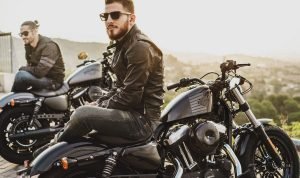Motorcycle Group Riding Hand Signals
Curated By Team Wild Triumph

How many riding signals do you really know if you’re preparing to go on a group ride or hit the track? It’s time for you to get familiar with these essential hand signals while riding a motorcycle. You may have come across a few of these if you took a motorcycle safety course, but if you aren’t using them on a regular basis there is a possibility you may have forgotten some important ones.
So let us talk about the hand signals, not the ones you use to indicate that you’re making a turn but the ones you use to talk to other motorcyclists. Even though some motorcyclists are using helmet communication systems, but almost all the signaling between bikers is actually done silently. Riders use a set of universal hand signals to convey important information about road safety, speed, or road conditions.
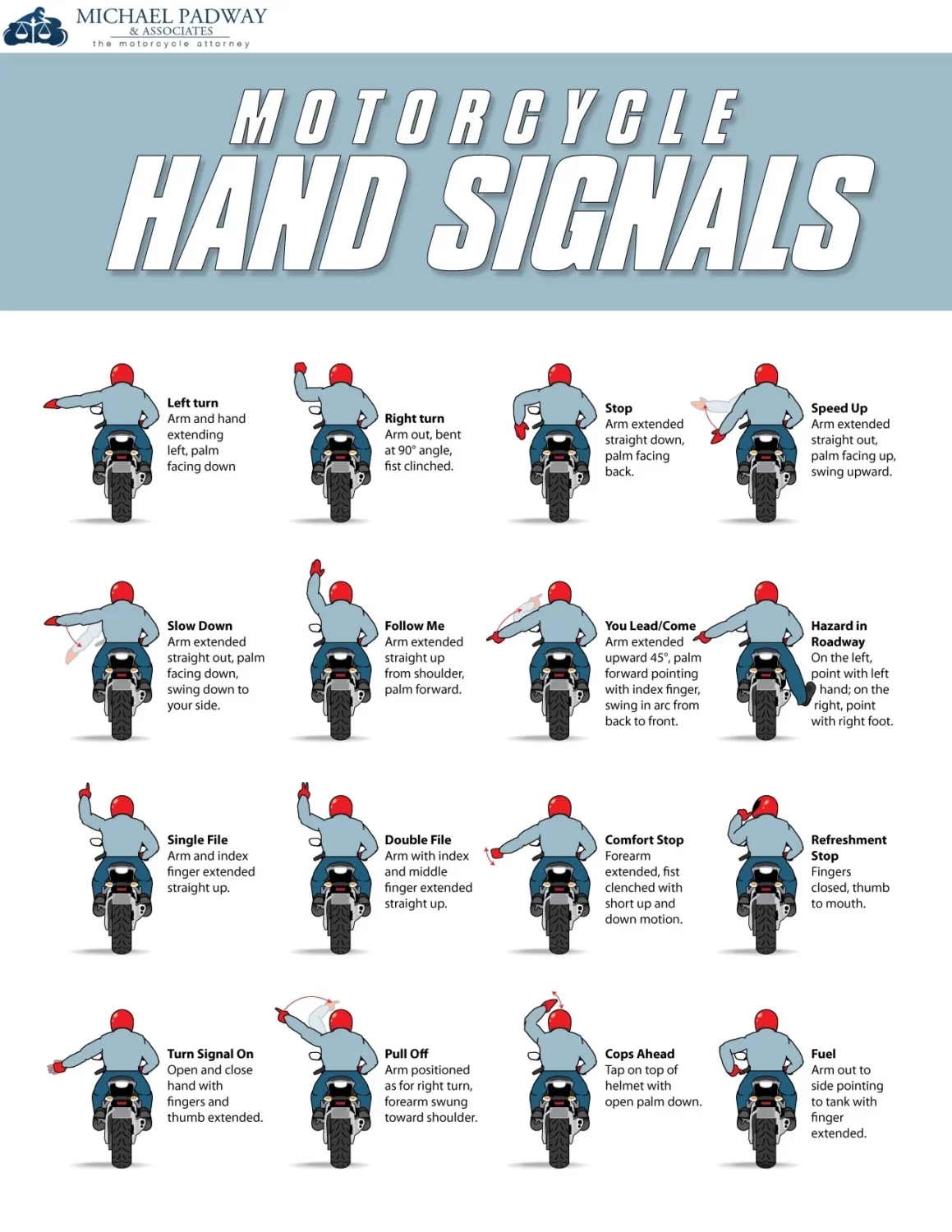
Importance of Hand Signals
Hand signals help to put together and coordinate among a group of bikers. They let your group or the rider behind you get an idea about an oncoming hazard or a turn. At times they are also used to convey a refreshment stop or a fuel stop. The use of these basic hand gestures for signaling have proved time and again that they are the best way to communicate to keep all your fellow riders on the same page.
Take an instance of a large group of motorcycle riders; if the lead rider unexpectedly stops or slows down without intimating the same, rider behind may face difficulty to adjust to the abrupt change in the riding style. Chances are that you may even cause a crash or a catastrophic accident. By using hand signals, the riders following you are prepared to coordinate and adjust according to the signals being made in a much controlled manner.
Motorcycle Hand Signals
Let’s start off with two signals you should definitely know even if you aren’t planning to ride in any groups. The turn signals; believe it or not, some motorcycles don’t even come with blinkers and even if yours do, there’s always a chance that you might have a fuse or maybe you just prefer signaling by hand. Make sure you’re using at least a hand signal if you are not using blinkers.

Left Turn
Your left turn signal is as simple as sticking your left arm out with your palm facing down like the direction all left-handers are eventually going to go, both left and rights signals are imperative for riding alone or riding with the group. It lets the traffic around you know that you are preparing to make a turn and if you’re in a group it lets those behind you know to prepare for a turn.
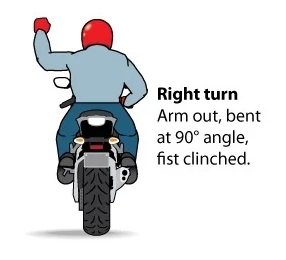
Right Turn
Right turn signal is pretty easy to remember, just signal that you’re turning right by bending your arm at the elbow with your clenched fist held high.

Stop Signal
The Stop signal is primarily for riding in groups. In the event your brake lights go out you could use it temporarily if you’re in traffic to signal a stop. Bend your arm at a right angle and point your fingers towards the ground. In a group ride the person leading the group is usually the one who’ll give the signal with a few folks imitating the same signal so that it reaches the last one riding in your group.
Most people in cars do not know these hand signals, but it will at least draw attention to the fact that something is going on and that’s better than just surprise for the car right behind you!
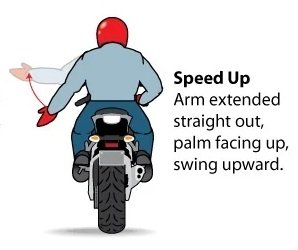
Speed Up
This signal lets riders in the group know to put a little more twist in their throttles. The signaling made for speed up and speed down is almost similar, so it is important to not get confused between the two. To speed up, stick your arm out with your palm facing upwards. Now slowly flap it up and down just like a bird’s wing. You can also tap on the rear fender of your bike as if it is a horse.

Slow Down
It is similar to speed up but the only difference is the face of your palm. Your palm needs to be faced downwards when you swing it from top to down like a bird’s wing.
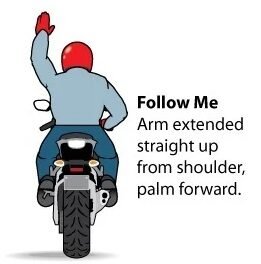
Follow Me
The follow me signal is used to let the rest of the group know who is taking over as leader. It also comes in handy if you’re in a really large group and there’s going to be few different leaders to split things up a bit. To let the rest of the group know to follow you, raise your hand like you are about to ask a question.

You Lead
You lead signal can be used to let individual riders know that they should follow you. Point out the rider’s bike you want to take the lead and then point out over the front of your bike. If you’re out on a ride and you receive the signal don’t forget to throw your arm up to let everyone else know that you’re the new leader as you zip to the front of your new found glory.

Hazard Ahead
It is most crucial and important signal if you are leading your group. Failing to do so can lead to catastrophic accidents and crashes. You do not want to be the guy responsible for that. To let riders following you know that there’s something on the road that is hazardous, you have to point to it with your left hand simultaneously poking your right foot out.

Single File
It means to get into a single-file line. To make this signal, raise your hand just like the way you are signaling as the leader and then hold up the number of fingers that’s equal to the number of files you want. If you want to ride as a single file use one finger, if you want to drive three files across then use three fingers.
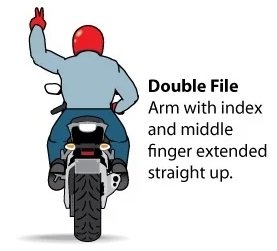
Double File
Similar to single file it means the number of files you want to ride across. So instead of using a single finger (like single-file), you denote two fingers signifying double file.
Depending upon the situation, if you find yourself in a state where more riders need to be side by side then by all means give the signal. In most groups you’re going to ride in a two-by-two format. The double file allows the person in front of you and the person next to you some riding space.
Pro Tip: Avoid signaling for a more than two column ride if the entire group is in a single lane on a highway.

Pull Off
Pull off signal is given when the group needs to pull off immediately or at the first available opportunity. To give this signal use the right turn signal and straighten your arm out to the side of your elbow. Make sure you give few up and down motions at the elbow and your group should get the message.

Comfort Stop
Pull your left arm straight out to your side, make a fist and act like you’re mixing a protein shake.
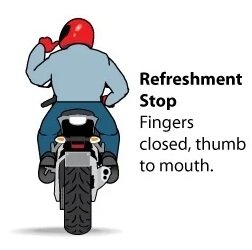
Refreshment Stop
Refreshment break can be signaled by giving thumbs up with your left hand and poking that thumb towards your mouth. A couple times it can also be a point towards your stomach or a rub on your stomach.
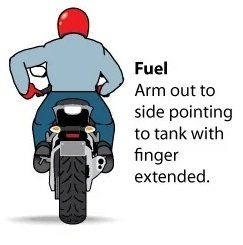
Fuel Signal
Fuel stops can be signaled by the leader of the group or can be sent up as the chain-of-command by someone else in the group who needs to make a fuel stop. All you need to do is just point to your gas tank.
Pro Tip: Don’t be the ‘pinhead’ that runs out of gas during a group ride. Make sure your tank is full before meeting with your group.

Turn Signal On
If you see someone while riding has left their blinkers on, extend your left arm and close your fist few times. You could save them a world of embarrassment by letting them know about this, and it’s quite common among bikers.
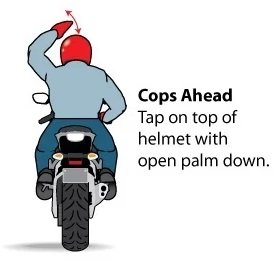
Cops Alert
Although we do not encourage the use of the cops ahead signal as a way to avoid law enforcement, but it is important particularly if you are young riders who is trying to avoid unnecessary speeding tickets. Tapping on the top of your helmet is a fool proof way to let other riders know around you or even for the rider on the other side of the highway to know that there are cops ahead.
What does it mean when bikers point two fingers down?
When motorcyclists come across while riding they usually greet each other with the two-finger peace gesture using their left hand. This means several things; for starters it’s their way of greeting the other ride or showing respect. They acknowledge their presence and communicate their love for riding. The peace sign with the two fingers pointing to the ground translates to keep the rubber side down. It’s the literal version of keeping the tires in contact with the road or in other words, ‘Ride Safe’.
However this gesture is used differently in countries. For example, there are countries that drive on the left-hand side of the road, so when a biker approaches from the opposite direction they’ll be on the right-hand side. They can’t greet each other with a wave because they will have to lift their hands off the throttle which is located on the right side of the handlebar. Not only is this inconvenient, it’s also dangerous. So their best way of acknowledging the passing rider is by nodding their heads. They could use the left hand out to do the gesture but the other motorcyclists won’t see it. Interestingly riders from these countries use their right hand to make the two-finger or tilted palm sign without leaving the throttle. It’s their way of appreciating or saying thank you to the people on the road.
Hand Signals for Dirt Bike Riders
Dirt bike riders and other off-roaders have their own set of signals as well. This can be especially important if you’re riding on narrow trails that feature oncoming traffic. Especially if the oncoming traffic is ATVs it is important to let the rider know about how many riders are behind you by pointing the finger count.
The most important one being the closed fist sign, meaning either you’re riding alone or you’re the last rider in the group. Try to keep these hand signals in mind the next time you’re on the road.
Keep it safe and keep the rubber side down 🙂
Special thanks to Michael Padway & Associates for creating these beautiful infographics!


